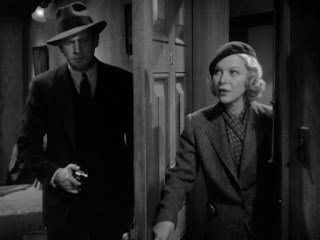The Ladykillers (released in 1955) was a late entry in the cycle of Ealing comedies produced from the late 40s to the late 50s by Britain’s Ealing Studios. It is usually regarded as the last truly great film in the cycle. Like so many of the Ealing comedies it stars Alec Guinness - in fact it was these films that made him a major star.
Alexander Mackendrick directed (and he directed three other Ealing comedies as well).
Professor Marcus (Alec Guinness) takes rooms at the lodgings of a sweet little old lady, Mrs Wilberforce (Katie Johnson). The professor explains that he and his four friends are members of a string quintet and they need rooms in which to practise. Mrs Wilberforce is delighted.
In fact the professor and his friends are desperate armed robbers planning a big heist at Kings Cross Station in London. The professor has a brilliant plan to get the loot safely away - he will trick Mrs Wilberforce into picking it up from the station. The coppers will never suspect that the trunk the old dear is collecting from the station contains the stolen money.
It’s a good plan and it almost works. Unfortunately Mrs Wilberforce gets a look at the money and she is understandably distressed. The gang have to find a way to persuade her not to go to the police. Eventually they decide that they maybe they will need to get rid of her, permanently. The problem is that she’s a sweet old thing and while they’re desperadoes they’re not really murderers. Mrs Wilberforce therefore poses a major problem.
Oddly enough, given that the Ealing comedies seem so quintessentially English the screenwriter was an expatriate American, William Rose (who claimed the story was based on a dream), and director Alexander Mackendrick was born in the US as well.
This is a very black comedy. Even today it would be regarded as very black comedy and in 1955 even more so.
There are six major characters. Mrs Wilberforce, played by veteran actress Katie Johnson. There’s Professor Marcus, there’s the pompous but disreputable Major Courtney (Cecil Parker), there’s failed boxer One-Round (Danny Green), spiv Louis (Herbert Lom) and Teddy Boy Harry (Peter Sellers getting his first major film rôle). But actually there’s a seventh character every bit as important - Mrs Wilberforce’s ramshackle rather absurd lop-sided house near St Pancras Station. Alexander Mackendrick had very definite ideas about what the house had to look like and when he couldn’t find a suitable house he had one built - not just a set but a whole house.
Alec Guinness appears to be channeling Alistair Sim which is no coincidence since the part was originally earmarked for Sim (who would have had a field day with it). Guinness however had established himself as a solid box-office draw for Ealing so he was given the part. He plays the professor as a mad genius, with bizarre phony teeth. All the characters are absurd and outrageous and yet somehow rather human. They consider themselves to be hardened criminals but they’re just not as hard as they imagine themselves to be. They’re not really a match for a little old lady.

At first Mrs Wilberforce seems like character from a different movie. But that’s exactly the point. She really does come from a different universe. She proudly tells the crooks that her late husband (a sea captain) went down with his ship in a typhoon, giving the salute on the bridge, having first ensured that his beloved parrots were safely settled in a lifeboat. It’s a perfect mixture of Victorian sentimentality and heroism and that’s the world Mrs Wilberforce still lives in.
Even with Alec Guinness going superbly over the top it would be unfair to single out one of the six stars - all the performances work splendidly and all the performers work together splendidly. As an added bonus there’s the great Frankie Howerd in a minor rôle.
And then there’s the wonderful twist right at the end when the police are informed. I’m not going to spoil it for you but it’s a lovely ironic-comic touch.
The movie was shot in the old three-strip Technicolor process, somewhat to Mackendrick’s dismay. He preferred black-and-white and he wanted a sombre grim look which was almost impossible to achieve with three-strip Technicolor. Somehow Mackendrick and his cinematographer Otto Heller managed to do it and it works.
The StudioCanal Blu-Ray offers plenty of extras, the highlights being an introduction by Terry Gilliam (a huge fan of the film) and an extremely informative audio commentary by Phil Kemp. There are also several interviews and a documentary on Ealing Studios. StudioCanal have also released this movie on DVD.
Apart from being funny and very dark
The Ladykillers also has a delightfully grotesque feel to it. It’s even at times quite macabre. Professor Marcus could almost have stepped out of a gothic horror movie and Mrs Wilberforce’s house would have been a perfect setting for such a film.
The Ladykillers is a wickedly delicious black comedy. Very highly recommended.



























